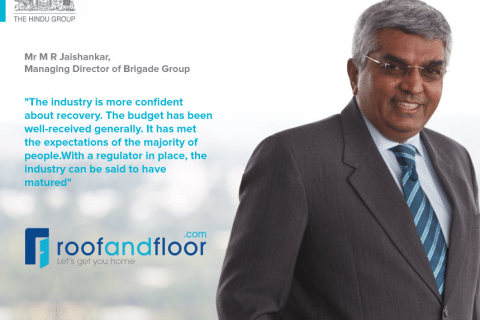Indian real estate industry is a vital cog in the country’s economy. This sector is one of the major employment providers as well as a key player in pushing infrastructure development and connectivity. The strong economic growth of the country is one of the factors behind the growth of the Indian real estate sector. The state of infrastructure has picked up momentum.
Foreign investors are now welcome to invest in the sector. Recently Deutsche Bank projected India’s GDP growth at 7.8% in 2017.
So what can we expect from the Indian real estate industry in 2017?
For Buyers
o Home loan interest rates will continue to drop
Right now, home loan interest rates vary from 9.25-11% and are amongst the lowest in the last 5 years. With the RBI announcing successive cuts in repo rates, there is more pressure on the banks to pass on the benefits to customers. With a further drop in interest rates, more and more first-time home buyers are expected to enter the market.
o Demonetization impact on residential real estate
Demonetization augurs well for home buyers, at least in the short to medium term period. While builders are not expected to reduce prices, industry experts say they will be more open to negotiating on property price and other benefits. Also, in resale and land transactions, look out for distress sales. In luxury housing, prices are expected to fall in the short to medium term, which means more options for home buyers. Although demand is expected to stabilize in 6 months, impact of demonetization will take some more time to make an accurate prediction.
o Lower inflation can raise property prices
The Reserve Bank of India has announced that it will work to cap inflation at 5% by March 2017. This will reduce cost of borrowing, making buyers look out for home loans thus raising demand and in return, raising property prices. However, remember that is expected to happen in the long run.
For Builders
o Real Estate Regulatory Act
The introduction of the Real Estate Regulatory Act has been a revolutionary initiative. According to RERA, builders have to park 70% of project funds in bank accounts. This will place the onus on builders to focus on finishing up projects impacting the number of project launches. The Government of India hopes the Act will bring in transparency and enforce timely completion of projects.
o Infrastructure development will boost real estate
As infrastructure projects get more financial backing from the government, stalled projects across the country are expected to get a kick start. Better infrastructure results in better connectivity across locations which can catalyse commercial and residential real estate. Various Government initiatives like Make in India, StartUp India and Skill India is expected to ring in changes in how India does business. And combined with an expected increase in foreign direct investment, Indian real estate growth is expected to touch a projected 7.8%. Foreign investment in India’s real estate sector is also expected to revitalize a flagging industry that has been plagued with liquidity crunch in the past few years. The “Housing for All by 2022” scheme is an ambitious plan to provide affordable housing for people of the economically lower segment, slum rehabilitation and subsidy for house construction.
o Unsold Inventory – A headache for developers
The Indian real estate has been faced with a crippling rise of unsold inventory; especially in the past few years. A spectacular rise in property rises since 2012 is credited with causing this scenario. According to rough industry estimates, unsold inventory in Mumbai is 1.73 lakh units while Bengaluru and Noida has 1.08 lakh and 1.01 lakh unsold units respectively. As per the Reserve Bank of India, the nationwide housing price index has slowed to 13.7%.
All major cities, with the exception of Chennai and Bengaluru, have exhibited slowing momentum. As per figures from April 2016*:
- Prices in Delhi rose 21.9% year-on-year in Q3 2015 which was slower than the first and second quarters’ 26.5% and 22.7%, respectively.
- In Mumbai, house price rises weakened to 10.8% (5.8% inflation-adjusted) from 11.0% in Q1 and 11.1% in Q2.
- In Ahmedabad, growth slowed to 7.4% (2.6% inflation-adjusted) from 9.2% in Q1 and 7.4% in Q2.
- In Kolkata, growth was 7.1% (2.3% inflation-adjusted), down from 32.4% in Q1 and 19.1% in Q2.
- Prices in Kochi even fell by 7.2% (-11.3% inflation-adjusted)
- Bangalore price rises, on the other hand, have been gaining momentum from 10.0% in Q1 and 15.5% in Q2 to 19.1% (13.8% inflation-adjusted) in Q3.
- Price growth in Chennai is also impressive at 12.4% (7.4% inflation-adjusted) in Q3, up from 4.9% in Q1 and 3.8% in Q2.
*Source: http://www.globalpropertyguide.com/Asia/India/Price-History
How do various segments within the sector stack up?
- Affordable Housing: This is mainly for the economically weaker section of our citizens. Experts say that India will require at least 40-45 million housing units by 2028. As per new government regulations, loans for these houses have to be 1.5-2% cheaper than market rates and cheaper rates should help in increased absorption of such units.
- Luxury Housing: This is the fastest growing segment in the country today. Between 2008-2012, about 182 luxury projects have been developed. India’s HNI segment is expected to triple by 2017; consequently, there is rising demand for villas, penthouses and high-end apartments with additional luxury features.
- Industrial Housing: With the growth of e-commerce, the demand for warehousing and transportation has increased proportionally. The implementation of Goods and Services Tax (GST) is also expected to create further demand. The Delhi Mumbai Industrial Corridor (DMIC) has seen a significant boost in real estate.
- Retail Housing: This is a major player in the real estate sector. Riding on the growth seen in 2015 and 2016, this sector will continue to see expansion. The CAGR (compound annual growth rate) could be seen growing by 8% from US$ 518 Billion in 2012 to US$ 850 Billion in 2017. The absorption rate is expected to touch 15 million sq ft by the end of 2017.
- Commercial Offices: Commercial real estate is a major occupier of land – currently, there is almost 70 million sq ft in use as office space. There has been an increase in space occupied by domestic companies and MNCs in major Tier 1 and Tier 2 cities. This demand is expected to grow to over 90 million sq ft in 2017.
The real estate industry has high hopes from 2017. Homebuyers and developers both are equally bullish on the sector in the coming year. Various government initiatives to regulate the industry and to boost our economy should create a scenario of economic and infrastructure development, better connectivity leading to better productivity can, in the long term, influence the Indian real estate industry.







Nice Information for a Real Estate learner…it is Really helpful
http://www.shreeramgroup.com/
We are overwhelmed by your feedback. We will ensure to continue giving you better user experience.
Feel free to reach us at 180030026115 or email us at support@roofandfloor.com with any queries.
Shree Mangal Projects are developers who provide quality living with security features, facilities in vicinity , amenities, value engineering in housing .For more enquiries call 962 370 0600 or email at sales@smpreality.in